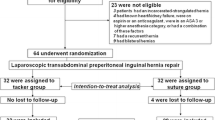Abstract
Background: In laparoscopic inguinal hernia repair controversy exists concerning the most appropriate repair method and implant material to use if intraabdominal adhesions are to be minimized.
Methods. In 108 pigs, we implanted three different types of mesh by both the TAPP (transabdominal preperitoneal) and Onlay (prosthesis placed directly upon the peritoneum) methods. Specimens were harvested in three time periods and adhesion formation was compared.
Results. Average adhesions at 3 days were TAPP 18% and Onlay 49% (p < 0.001). At 3 weeks average adhesions were TAPP 8% and Onlay 23% (p < 0.04). Three-month figures were TAPP 1% and Onlay 13% (p < 0.001). In contrast, there were no differences in adhesion formation due to material type in any of the three time periods (all p > 0.17).
Conclusions: A peritoneal covering over a laparoscopic inguinal implant significantly reduced adhesions. Prosthetic material type did not affect adhesion formation in this study.
Similar content being viewed by others
Author information
Authors and Affiliations
Additional information
Received: 22 August 1996/Accepted: 13 November 1996
Rights and permissions
About this article
Cite this article
Vader, V., Vogt, D., Zucker, K. et al. Adhesion formation in laparoscopic inguinal hernia repair. Surg Endosc 11, 825–829 (1997). https://doi.org/10.1007/s004649900463
Published:
Issue Date:
DOI: https://doi.org/10.1007/s004649900463




